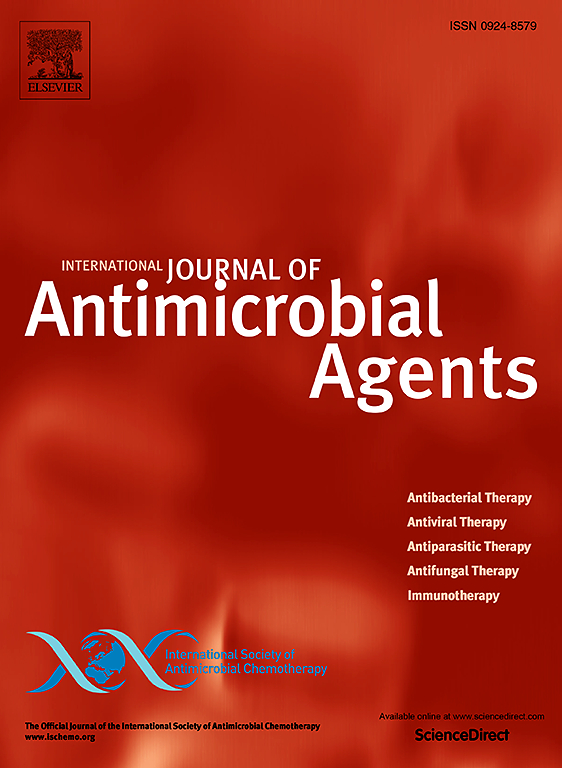一种精确的无扩增CRISPR/ cas12检测GES β-内酰胺酶的方法
IF 4.6
2区 医学
Q1 INFECTIOUS DISEASES
International Journal of Antimicrobial Agents
Pub Date : 2025-04-03
DOI:10.1016/j.ijantimicag.2025.107506
引用次数: 0
摘要
圭亚那扩展谱(GES) β-内酰胺酶属于少数A类β-内酰胺酶,由于缺乏特异性诊断测试,可能未被充分诊断。因此,迫切需要开发新的分子诊断工具,以填补罕见β-内酰胺酶检测方面的空白。在此,我们提出了一种优化的、无扩增的基于CRISPR/ cas12的检测GES β-内酰胺酶的方法,并验证了其在临床分离株中的应用。根据79份标准标本的检测结果,所提出的检测方法在不到1.5小时内具有100%的灵敏度和特异性,以及100%的阳性和阴性预测值。我们通过利用多重crRNA策略、高效DNA报告基因(ttat - 5c)和小鼠RNase抑制剂来优化CRISPR/Cas12a方法,以防止crRNA降解。对肠杆菌和铜绿假单胞菌的检出限分别为1ng/μL和3ng/μL。观察到的差异是由于blaGES基因的位置。在铜绿假单胞菌中,该基因出现在染色体整合子中,只存在于1至3个拷贝中,而在肠杆菌中,它出现在质粒中,存在于多个拷贝中。该方法可作为临床微生物实验室的常规诊断工具,填补GES β-内酰胺酶商业化诊断检测的空白。本文章由计算机程序翻译,如有差异,请以英文原文为准。

An accurate amplification-free CRISPR/Cas12a-based assay for GES β-lactamase detection
Objective
Guiana-Extended-Spectrum (GES) β-lactamases belong to the minor class A β-lactamases and are probably underdiagnosed due to a lack of specific diagnostic tests. There is therefore an urgent need to develop new molecular diagnostic tools that will be able to fill the gap in the detection of rare β-lactamases. Here, we propose an optimized, amplification-free CRISPR/Cas12a-based assay for the accurate detection of GES β-lactamases and we validate its application with clinical isolates (Graphic abstract). Based on the results of examination of 79 standard collection, the proposed assay exhibited 100% sensitivity and specificity, as well as 100% positive and negative predictive values in less than 1.5 hours.
Methods
We optimized the CRISPR/Cas12a method by harnessing a multiplex crRNA strategy, a highly efficient DNA reporter (TTATT-5C) and the Murine RNase Inhibitor to prevent crRNA degradation.
Results
Our yielded limits of detection of 1 ng/µL and 3 ng/µL in Enterobacterales and Pseudomonas aeruginosa, respectively. The observed difference is due to the location of the blaGES gene. The gene occurs in a chromosomal integron present only in one to three copies in P. aeruginosa, whereas it occurs in plasmids present in multiple copies in Enterobacterales.
Conclusions
The proposed method could be established as a routine diagnostic tool in clinical microbiology laboratories to fill the gap in availability of commercial diagnostic tests for GES β-lactamases.
求助全文
通过发布文献求助,成功后即可免费获取论文全文。
去求助
来源期刊
CiteScore
21.60
自引率
0.90%
发文量
176
审稿时长
36 days
期刊介绍:
The International Journal of Antimicrobial Agents is a peer-reviewed publication offering comprehensive and current reference information on the physical, pharmacological, in vitro, and clinical properties of individual antimicrobial agents, covering antiviral, antiparasitic, antibacterial, and antifungal agents. The journal not only communicates new trends and developments through authoritative review articles but also addresses the critical issue of antimicrobial resistance, both in hospital and community settings. Published content includes solicited reviews by leading experts and high-quality original research papers in the specified fields.

 求助内容:
求助内容: 应助结果提醒方式:
应助结果提醒方式:


